A Comprehensive Report on Curriculum: Biology Education at University
VerifiedAdded on 2023/01/17
|11
|3947
|22
Report
AI Summary
This report provides a detailed analysis of curriculum in the context of biology education. It begins by defining curriculum and then differentiates between intended and enacted curriculums, explaining their objectives and processes. The report describes the enacted curriculum, focusing on teacher ...
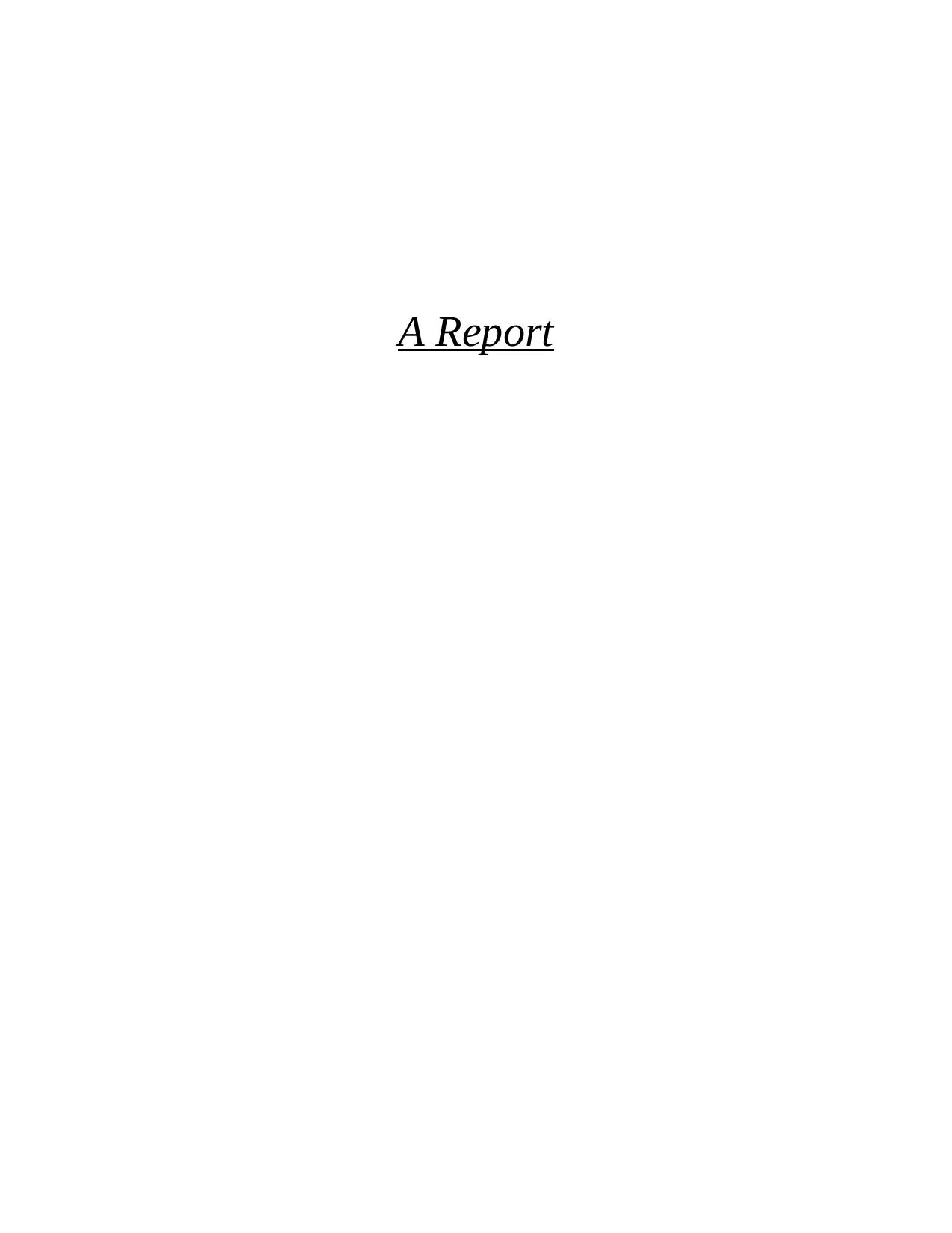
A Report
Paraphrase This Document
Need a fresh take? Get an instant paraphrase of this document with our AI Paraphraser

Table of Contents
INTRODUCTION...........................................................................................................................3
TASK 1............................................................................................................................................3
a) Intended Curriculum and Enacted Curriculum........................................................................3
b) Description of Implemented or Enacted Curriculum..............................................................3
c) Orientations to Curriculum......................................................................................................5
d) Awareness of Curriculum and Development in Curriculum...................................................7
e) Tensions Due to Congruence Between Intended and Enacted Curriculum.............................8
REFLECTION.................................................................................................................................9
CONCLUSION..............................................................................................................................10
REFERENCES..............................................................................................................................11
INTRODUCTION...........................................................................................................................3
TASK 1............................................................................................................................................3
a) Intended Curriculum and Enacted Curriculum........................................................................3
b) Description of Implemented or Enacted Curriculum..............................................................3
c) Orientations to Curriculum......................................................................................................5
d) Awareness of Curriculum and Development in Curriculum...................................................7
e) Tensions Due to Congruence Between Intended and Enacted Curriculum.............................8
REFLECTION.................................................................................................................................9
CONCLUSION..............................................................................................................................10
REFERENCES..............................................................................................................................11
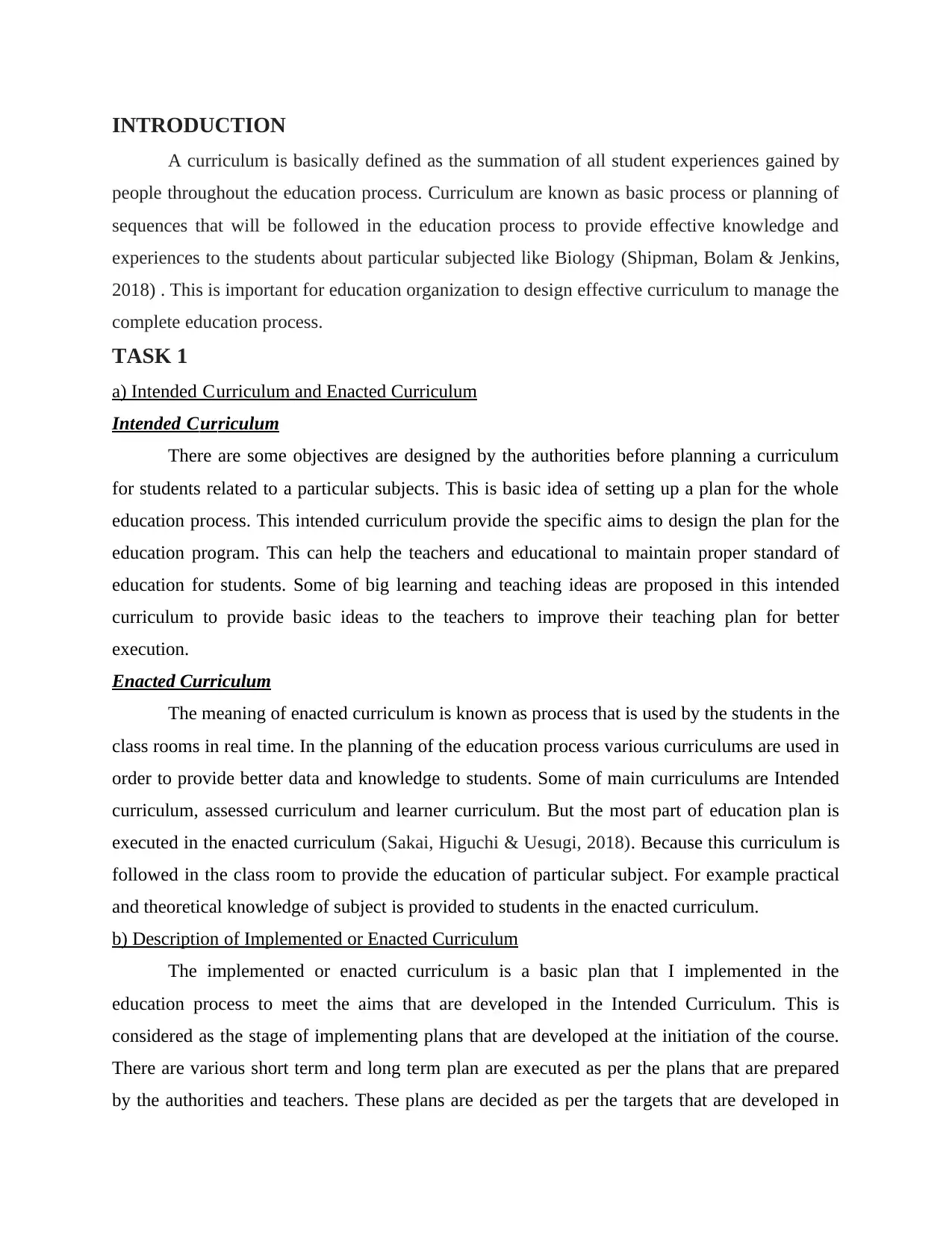
INTRODUCTION
A curriculum is basically defined as the summation of all student experiences gained by
people throughout the education process. Curriculum are known as basic process or planning of
sequences that will be followed in the education process to provide effective knowledge and
experiences to the students about particular subjected like Biology (Shipman, Bolam & Jenkins,
2018) . This is important for education organization to design effective curriculum to manage the
complete education process.
TASK 1
a) Intended Curriculum and Enacted Curriculum
Intended Curriculum
There are some objectives are designed by the authorities before planning a curriculum
for students related to a particular subjects. This is basic idea of setting up a plan for the whole
education process. This intended curriculum provide the specific aims to design the plan for the
education program. This can help the teachers and educational to maintain proper standard of
education for students. Some of big learning and teaching ideas are proposed in this intended
curriculum to provide basic ideas to the teachers to improve their teaching plan for better
execution.
Enacted Curriculum
The meaning of enacted curriculum is known as process that is used by the students in the
class rooms in real time. In the planning of the education process various curriculums are used in
order to provide better data and knowledge to students. Some of main curriculums are Intended
curriculum, assessed curriculum and learner curriculum. But the most part of education plan is
executed in the enacted curriculum (Sakai, Higuchi & Uesugi, 2018). Because this curriculum is
followed in the class room to provide the education of particular subject. For example practical
and theoretical knowledge of subject is provided to students in the enacted curriculum.
b) Description of Implemented or Enacted Curriculum
The implemented or enacted curriculum is a basic plan that I implemented in the
education process to meet the aims that are developed in the Intended Curriculum. This is
considered as the stage of implementing plans that are developed at the initiation of the course.
There are various short term and long term plan are executed as per the plans that are prepared
by the authorities and teachers. These plans are decided as per the targets that are developed in
A curriculum is basically defined as the summation of all student experiences gained by
people throughout the education process. Curriculum are known as basic process or planning of
sequences that will be followed in the education process to provide effective knowledge and
experiences to the students about particular subjected like Biology (Shipman, Bolam & Jenkins,
2018) . This is important for education organization to design effective curriculum to manage the
complete education process.
TASK 1
a) Intended Curriculum and Enacted Curriculum
Intended Curriculum
There are some objectives are designed by the authorities before planning a curriculum
for students related to a particular subjects. This is basic idea of setting up a plan for the whole
education process. This intended curriculum provide the specific aims to design the plan for the
education program. This can help the teachers and educational to maintain proper standard of
education for students. Some of big learning and teaching ideas are proposed in this intended
curriculum to provide basic ideas to the teachers to improve their teaching plan for better
execution.
Enacted Curriculum
The meaning of enacted curriculum is known as process that is used by the students in the
class rooms in real time. In the planning of the education process various curriculums are used in
order to provide better data and knowledge to students. Some of main curriculums are Intended
curriculum, assessed curriculum and learner curriculum. But the most part of education plan is
executed in the enacted curriculum (Sakai, Higuchi & Uesugi, 2018). Because this curriculum is
followed in the class room to provide the education of particular subject. For example practical
and theoretical knowledge of subject is provided to students in the enacted curriculum.
b) Description of Implemented or Enacted Curriculum
The implemented or enacted curriculum is a basic plan that I implemented in the
education process to meet the aims that are developed in the Intended Curriculum. This is
considered as the stage of implementing plans that are developed at the initiation of the course.
There are various short term and long term plan are executed as per the plans that are prepared
by the authorities and teachers. These plans are decided as per the targets that are developed in
⊘ This is a preview!⊘
Do you want full access?
Subscribe today to unlock all pages.

Trusted by 1+ million students worldwide
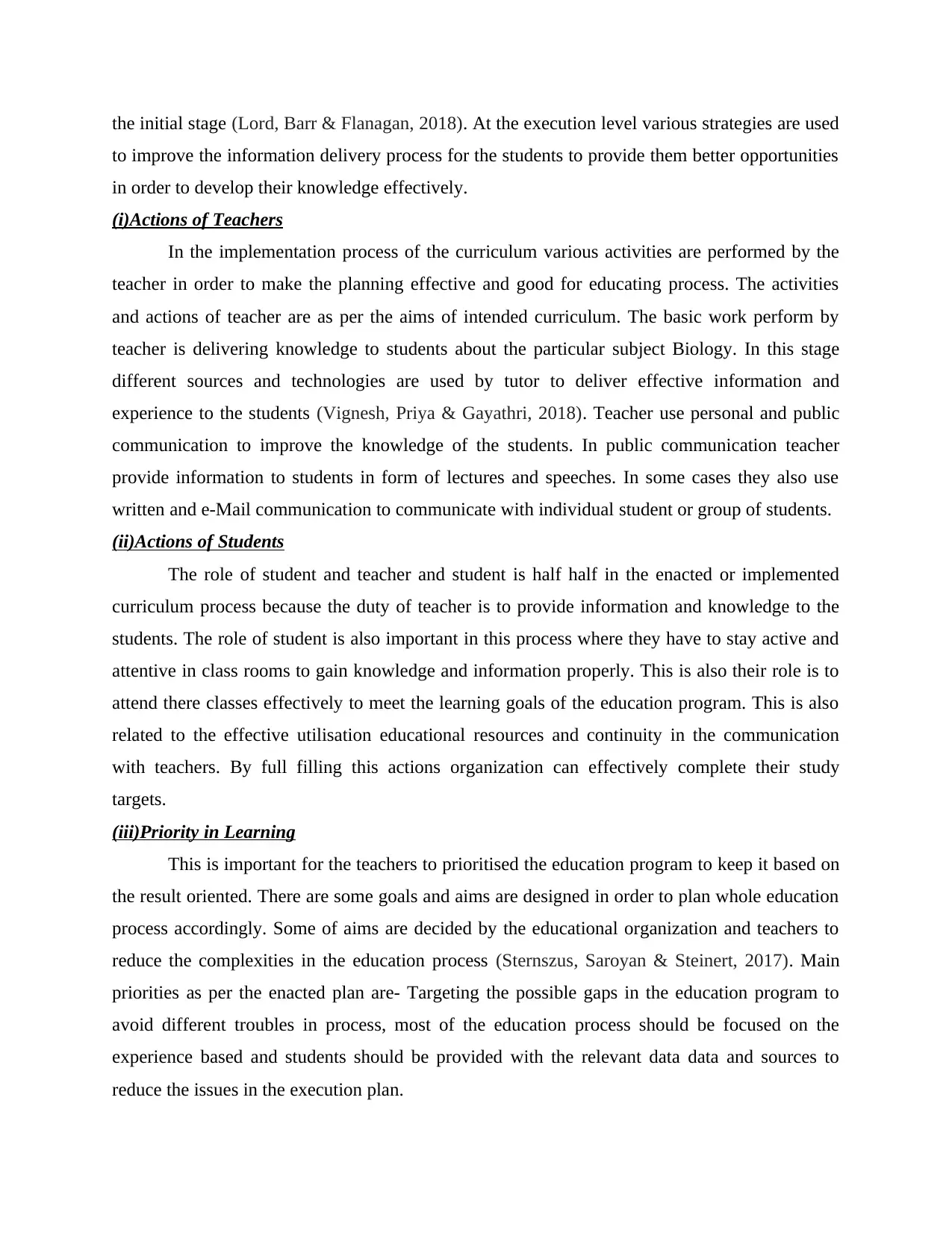
the initial stage (Lord, Barr & Flanagan, 2018). At the execution level various strategies are used
to improve the information delivery process for the students to provide them better opportunities
in order to develop their knowledge effectively.
(i)Actions of Teachers
In the implementation process of the curriculum various activities are performed by the
teacher in order to make the planning effective and good for educating process. The activities
and actions of teacher are as per the aims of intended curriculum. The basic work perform by
teacher is delivering knowledge to students about the particular subject Biology. In this stage
different sources and technologies are used by tutor to deliver effective information and
experience to the students (Vignesh, Priya & Gayathri, 2018). Teacher use personal and public
communication to improve the knowledge of the students. In public communication teacher
provide information to students in form of lectures and speeches. In some cases they also use
written and e-Mail communication to communicate with individual student or group of students.
(ii)Actions of Students
The role of student and teacher and student is half half in the enacted or implemented
curriculum process because the duty of teacher is to provide information and knowledge to the
students. The role of student is also important in this process where they have to stay active and
attentive in class rooms to gain knowledge and information properly. This is also their role is to
attend there classes effectively to meet the learning goals of the education program. This is also
related to the effective utilisation educational resources and continuity in the communication
with teachers. By full filling this actions organization can effectively complete their study
targets.
(iii)Priority in Learning
This is important for the teachers to prioritised the education program to keep it based on
the result oriented. There are some goals and aims are designed in order to plan whole education
process accordingly. Some of aims are decided by the educational organization and teachers to
reduce the complexities in the education process (Sternszus, Saroyan & Steinert, 2017). Main
priorities as per the enacted plan are- Targeting the possible gaps in the education program to
avoid different troubles in process, most of the education process should be focused on the
experience based and students should be provided with the relevant data data and sources to
reduce the issues in the execution plan.
to improve the information delivery process for the students to provide them better opportunities
in order to develop their knowledge effectively.
(i)Actions of Teachers
In the implementation process of the curriculum various activities are performed by the
teacher in order to make the planning effective and good for educating process. The activities
and actions of teacher are as per the aims of intended curriculum. The basic work perform by
teacher is delivering knowledge to students about the particular subject Biology. In this stage
different sources and technologies are used by tutor to deliver effective information and
experience to the students (Vignesh, Priya & Gayathri, 2018). Teacher use personal and public
communication to improve the knowledge of the students. In public communication teacher
provide information to students in form of lectures and speeches. In some cases they also use
written and e-Mail communication to communicate with individual student or group of students.
(ii)Actions of Students
The role of student and teacher and student is half half in the enacted or implemented
curriculum process because the duty of teacher is to provide information and knowledge to the
students. The role of student is also important in this process where they have to stay active and
attentive in class rooms to gain knowledge and information properly. This is also their role is to
attend there classes effectively to meet the learning goals of the education program. This is also
related to the effective utilisation educational resources and continuity in the communication
with teachers. By full filling this actions organization can effectively complete their study
targets.
(iii)Priority in Learning
This is important for the teachers to prioritised the education program to keep it based on
the result oriented. There are some goals and aims are designed in order to plan whole education
process accordingly. Some of aims are decided by the educational organization and teachers to
reduce the complexities in the education process (Sternszus, Saroyan & Steinert, 2017). Main
priorities as per the enacted plan are- Targeting the possible gaps in the education program to
avoid different troubles in process, most of the education process should be focused on the
experience based and students should be provided with the relevant data data and sources to
reduce the issues in the execution plan.
Paraphrase This Document
Need a fresh take? Get an instant paraphrase of this document with our AI Paraphraser
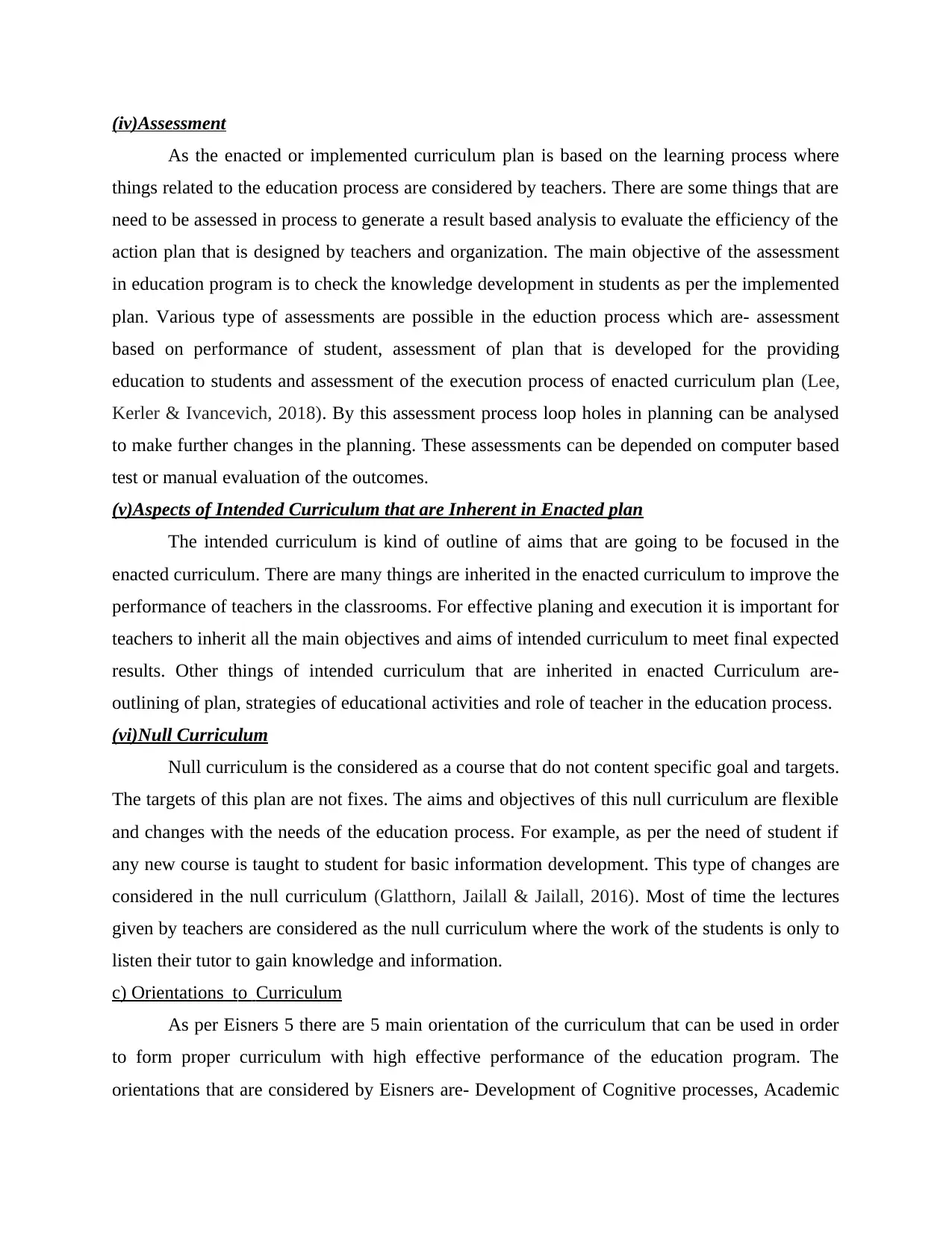
(iv)Assessment
As the enacted or implemented curriculum plan is based on the learning process where
things related to the education process are considered by teachers. There are some things that are
need to be assessed in process to generate a result based analysis to evaluate the efficiency of the
action plan that is designed by teachers and organization. The main objective of the assessment
in education program is to check the knowledge development in students as per the implemented
plan. Various type of assessments are possible in the eduction process which are- assessment
based on performance of student, assessment of plan that is developed for the providing
education to students and assessment of the execution process of enacted curriculum plan (Lee,
Kerler & Ivancevich, 2018). By this assessment process loop holes in planning can be analysed
to make further changes in the planning. These assessments can be depended on computer based
test or manual evaluation of the outcomes.
(v)Aspects of Intended Curriculum that are Inherent in Enacted plan
The intended curriculum is kind of outline of aims that are going to be focused in the
enacted curriculum. There are many things are inherited in the enacted curriculum to improve the
performance of teachers in the classrooms. For effective planing and execution it is important for
teachers to inherit all the main objectives and aims of intended curriculum to meet final expected
results. Other things of intended curriculum that are inherited in enacted Curriculum are-
outlining of plan, strategies of educational activities and role of teacher in the education process.
(vi)Null Curriculum
Null curriculum is the considered as a course that do not content specific goal and targets.
The targets of this plan are not fixes. The aims and objectives of this null curriculum are flexible
and changes with the needs of the education process. For example, as per the need of student if
any new course is taught to student for basic information development. This type of changes are
considered in the null curriculum (Glatthorn, Jailall & Jailall, 2016). Most of time the lectures
given by teachers are considered as the null curriculum where the work of the students is only to
listen their tutor to gain knowledge and information.
c) Orientations to Curriculum
As per Eisners 5 there are 5 main orientation of the curriculum that can be used in order
to form proper curriculum with high effective performance of the education program. The
orientations that are considered by Eisners are- Development of Cognitive processes, Academic
As the enacted or implemented curriculum plan is based on the learning process where
things related to the education process are considered by teachers. There are some things that are
need to be assessed in process to generate a result based analysis to evaluate the efficiency of the
action plan that is designed by teachers and organization. The main objective of the assessment
in education program is to check the knowledge development in students as per the implemented
plan. Various type of assessments are possible in the eduction process which are- assessment
based on performance of student, assessment of plan that is developed for the providing
education to students and assessment of the execution process of enacted curriculum plan (Lee,
Kerler & Ivancevich, 2018). By this assessment process loop holes in planning can be analysed
to make further changes in the planning. These assessments can be depended on computer based
test or manual evaluation of the outcomes.
(v)Aspects of Intended Curriculum that are Inherent in Enacted plan
The intended curriculum is kind of outline of aims that are going to be focused in the
enacted curriculum. There are many things are inherited in the enacted curriculum to improve the
performance of teachers in the classrooms. For effective planing and execution it is important for
teachers to inherit all the main objectives and aims of intended curriculum to meet final expected
results. Other things of intended curriculum that are inherited in enacted Curriculum are-
outlining of plan, strategies of educational activities and role of teacher in the education process.
(vi)Null Curriculum
Null curriculum is the considered as a course that do not content specific goal and targets.
The targets of this plan are not fixes. The aims and objectives of this null curriculum are flexible
and changes with the needs of the education process. For example, as per the need of student if
any new course is taught to student for basic information development. This type of changes are
considered in the null curriculum (Glatthorn, Jailall & Jailall, 2016). Most of time the lectures
given by teachers are considered as the null curriculum where the work of the students is only to
listen their tutor to gain knowledge and information.
c) Orientations to Curriculum
As per Eisners 5 there are 5 main orientation of the curriculum that can be used in order
to form proper curriculum with high effective performance of the education program. The
orientations that are considered by Eisners are- Development of Cognitive processes, Academic
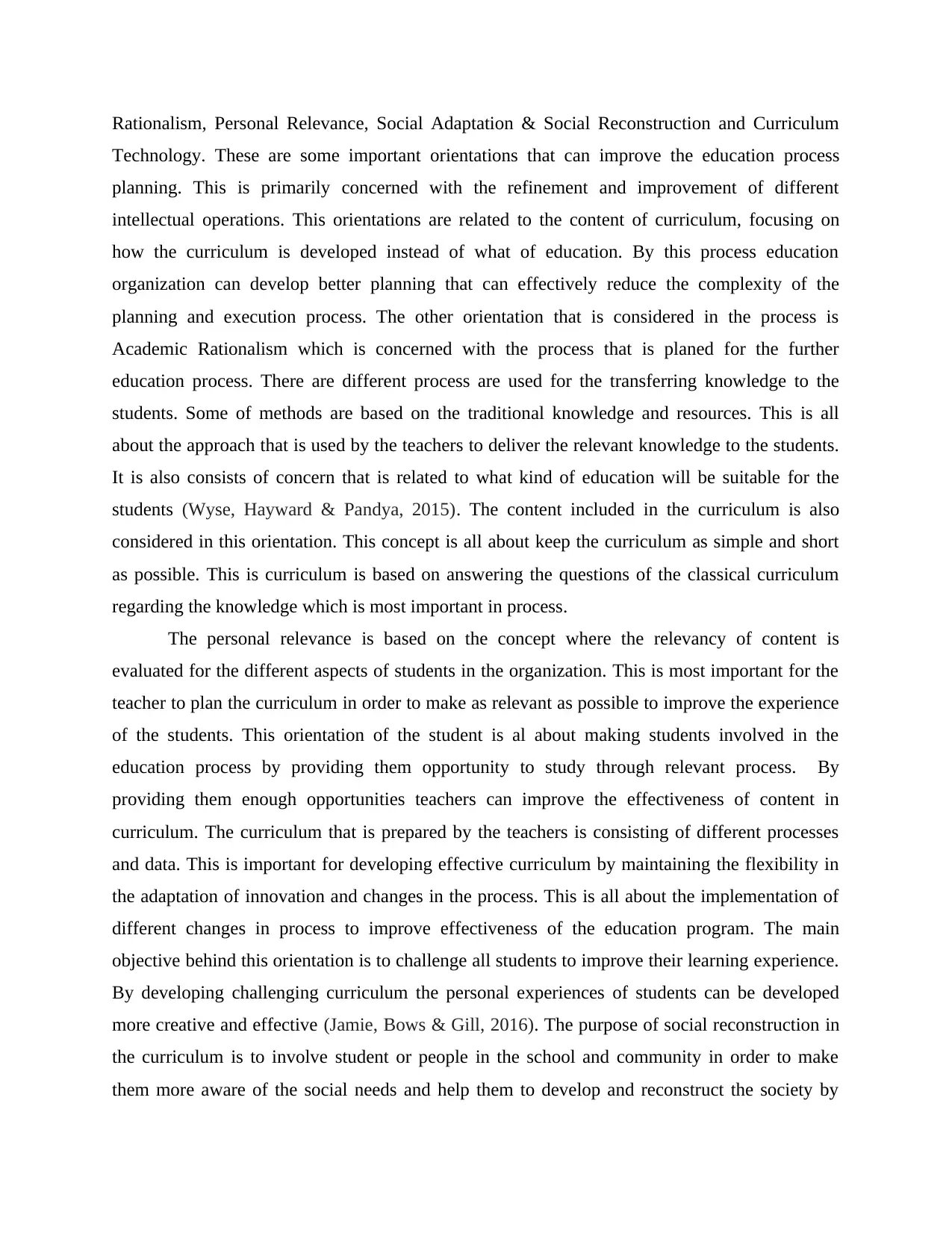
Rationalism, Personal Relevance, Social Adaptation & Social Reconstruction and Curriculum
Technology. These are some important orientations that can improve the education process
planning. This is primarily concerned with the refinement and improvement of different
intellectual operations. This orientations are related to the content of curriculum, focusing on
how the curriculum is developed instead of what of education. By this process education
organization can develop better planning that can effectively reduce the complexity of the
planning and execution process. The other orientation that is considered in the process is
Academic Rationalism which is concerned with the process that is planed for the further
education process. There are different process are used for the transferring knowledge to the
students. Some of methods are based on the traditional knowledge and resources. This is all
about the approach that is used by the teachers to deliver the relevant knowledge to the students.
It is also consists of concern that is related to what kind of education will be suitable for the
students (Wyse, Hayward & Pandya, 2015). The content included in the curriculum is also
considered in this orientation. This concept is all about keep the curriculum as simple and short
as possible. This is curriculum is based on answering the questions of the classical curriculum
regarding the knowledge which is most important in process.
The personal relevance is based on the concept where the relevancy of content is
evaluated for the different aspects of students in the organization. This is most important for the
teacher to plan the curriculum in order to make as relevant as possible to improve the experience
of the students. This orientation of the student is al about making students involved in the
education process by providing them opportunity to study through relevant process. By
providing them enough opportunities teachers can improve the effectiveness of content in
curriculum. The curriculum that is prepared by the teachers is consisting of different processes
and data. This is important for developing effective curriculum by maintaining the flexibility in
the adaptation of innovation and changes in the process. This is all about the implementation of
different changes in process to improve effectiveness of the education program. The main
objective behind this orientation is to challenge all students to improve their learning experience.
By developing challenging curriculum the personal experiences of students can be developed
more creative and effective (Jamie, Bows & Gill, 2016). The purpose of social reconstruction in
the curriculum is to involve student or people in the school and community in order to make
them more aware of the social needs and help them to develop and reconstruct the society by
Technology. These are some important orientations that can improve the education process
planning. This is primarily concerned with the refinement and improvement of different
intellectual operations. This orientations are related to the content of curriculum, focusing on
how the curriculum is developed instead of what of education. By this process education
organization can develop better planning that can effectively reduce the complexity of the
planning and execution process. The other orientation that is considered in the process is
Academic Rationalism which is concerned with the process that is planed for the further
education process. There are different process are used for the transferring knowledge to the
students. Some of methods are based on the traditional knowledge and resources. This is all
about the approach that is used by the teachers to deliver the relevant knowledge to the students.
It is also consists of concern that is related to what kind of education will be suitable for the
students (Wyse, Hayward & Pandya, 2015). The content included in the curriculum is also
considered in this orientation. This concept is all about keep the curriculum as simple and short
as possible. This is curriculum is based on answering the questions of the classical curriculum
regarding the knowledge which is most important in process.
The personal relevance is based on the concept where the relevancy of content is
evaluated for the different aspects of students in the organization. This is most important for the
teacher to plan the curriculum in order to make as relevant as possible to improve the experience
of the students. This orientation of the student is al about making students involved in the
education process by providing them opportunity to study through relevant process. By
providing them enough opportunities teachers can improve the effectiveness of content in
curriculum. The curriculum that is prepared by the teachers is consisting of different processes
and data. This is important for developing effective curriculum by maintaining the flexibility in
the adaptation of innovation and changes in the process. This is all about the implementation of
different changes in process to improve effectiveness of the education program. The main
objective behind this orientation is to challenge all students to improve their learning experience.
By developing challenging curriculum the personal experiences of students can be developed
more creative and effective (Jamie, Bows & Gill, 2016). The purpose of social reconstruction in
the curriculum is to involve student or people in the school and community in order to make
them more aware of the social needs and help them to develop and reconstruct the society by
⊘ This is a preview!⊘
Do you want full access?
Subscribe today to unlock all pages.

Trusted by 1+ million students worldwide
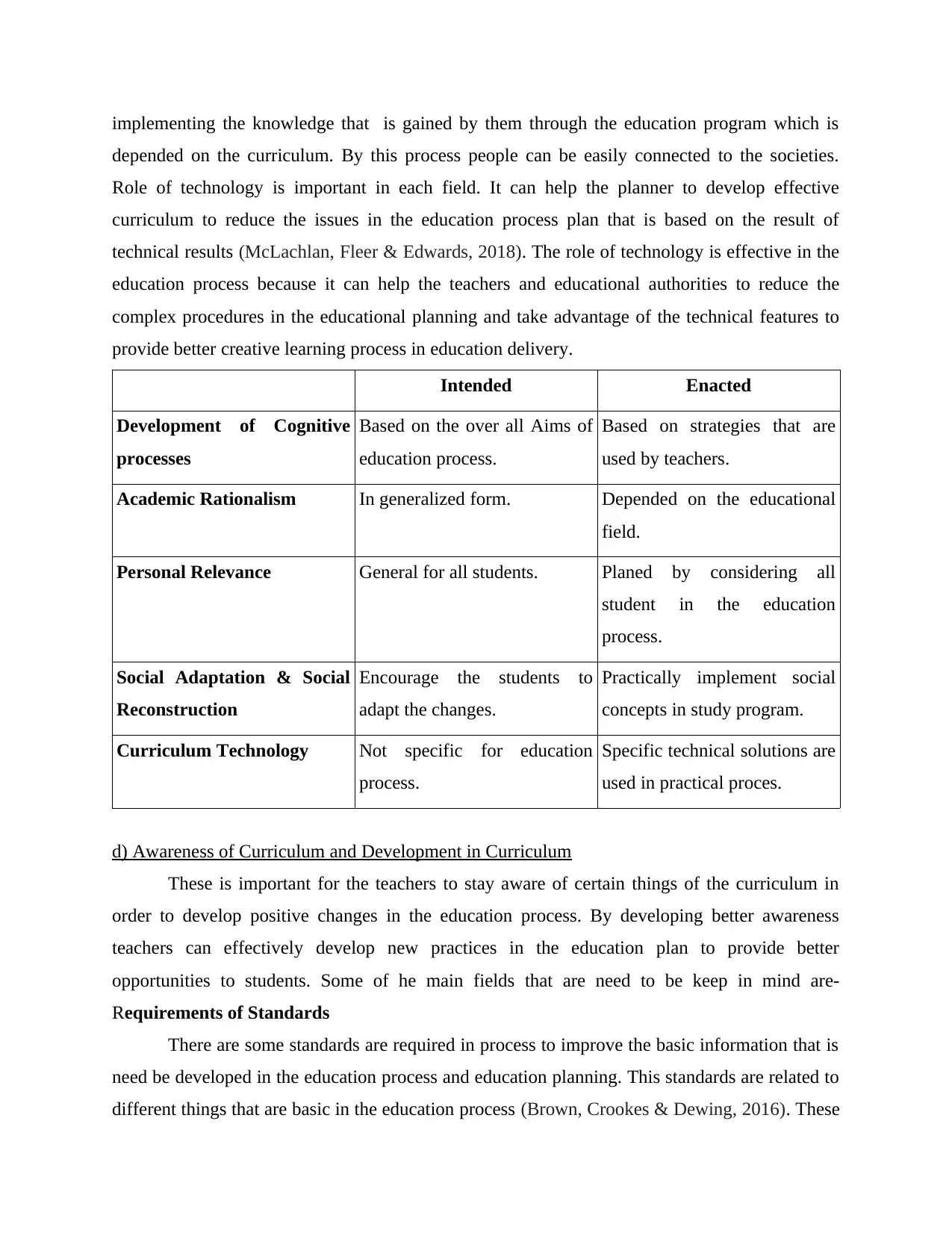
implementing the knowledge that is gained by them through the education program which is
depended on the curriculum. By this process people can be easily connected to the societies.
Role of technology is important in each field. It can help the planner to develop effective
curriculum to reduce the issues in the education process plan that is based on the result of
technical results (McLachlan, Fleer & Edwards, 2018). The role of technology is effective in the
education process because it can help the teachers and educational authorities to reduce the
complex procedures in the educational planning and take advantage of the technical features to
provide better creative learning process in education delivery.
Intended Enacted
Development of Cognitive
processes
Based on the over all Aims of
education process.
Based on strategies that are
used by teachers.
Academic Rationalism In generalized form. Depended on the educational
field.
Personal Relevance General for all students. Planed by considering all
student in the education
process.
Social Adaptation & Social
Reconstruction
Encourage the students to
adapt the changes.
Practically implement social
concepts in study program.
Curriculum Technology Not specific for education
process.
Specific technical solutions are
used in practical proces.
d) Awareness of Curriculum and Development in Curriculum
These is important for the teachers to stay aware of certain things of the curriculum in
order to develop positive changes in the education process. By developing better awareness
teachers can effectively develop new practices in the education plan to provide better
opportunities to students. Some of he main fields that are need to be keep in mind are-
Requirements of Standards
There are some standards are required in process to improve the basic information that is
need be developed in the education process and education planning. This standards are related to
different things that are basic in the education process (Brown, Crookes & Dewing, 2016). These
depended on the curriculum. By this process people can be easily connected to the societies.
Role of technology is important in each field. It can help the planner to develop effective
curriculum to reduce the issues in the education process plan that is based on the result of
technical results (McLachlan, Fleer & Edwards, 2018). The role of technology is effective in the
education process because it can help the teachers and educational authorities to reduce the
complex procedures in the educational planning and take advantage of the technical features to
provide better creative learning process in education delivery.
Intended Enacted
Development of Cognitive
processes
Based on the over all Aims of
education process.
Based on strategies that are
used by teachers.
Academic Rationalism In generalized form. Depended on the educational
field.
Personal Relevance General for all students. Planed by considering all
student in the education
process.
Social Adaptation & Social
Reconstruction
Encourage the students to
adapt the changes.
Practically implement social
concepts in study program.
Curriculum Technology Not specific for education
process.
Specific technical solutions are
used in practical proces.
d) Awareness of Curriculum and Development in Curriculum
These is important for the teachers to stay aware of certain things of the curriculum in
order to develop positive changes in the education process. By developing better awareness
teachers can effectively develop new practices in the education plan to provide better
opportunities to students. Some of he main fields that are need to be keep in mind are-
Requirements of Standards
There are some standards are required in process to improve the basic information that is
need be developed in the education process and education planning. This standards are related to
different things that are basic in the education process (Brown, Crookes & Dewing, 2016). These
Paraphrase This Document
Need a fresh take? Get an instant paraphrase of this document with our AI Paraphraser
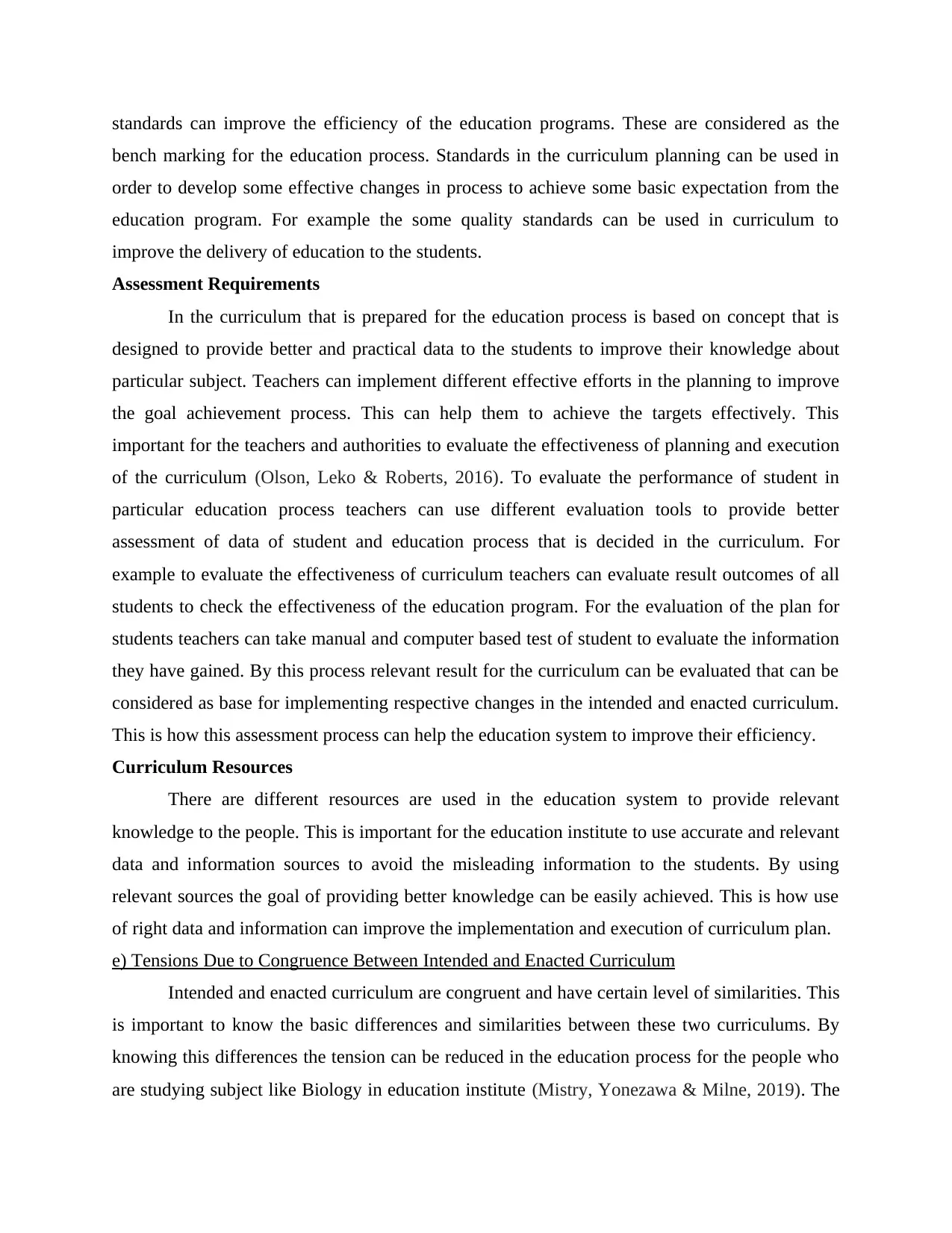
standards can improve the efficiency of the education programs. These are considered as the
bench marking for the education process. Standards in the curriculum planning can be used in
order to develop some effective changes in process to achieve some basic expectation from the
education program. For example the some quality standards can be used in curriculum to
improve the delivery of education to the students.
Assessment Requirements
In the curriculum that is prepared for the education process is based on concept that is
designed to provide better and practical data to the students to improve their knowledge about
particular subject. Teachers can implement different effective efforts in the planning to improve
the goal achievement process. This can help them to achieve the targets effectively. This
important for the teachers and authorities to evaluate the effectiveness of planning and execution
of the curriculum (Olson, Leko & Roberts, 2016). To evaluate the performance of student in
particular education process teachers can use different evaluation tools to provide better
assessment of data of student and education process that is decided in the curriculum. For
example to evaluate the effectiveness of curriculum teachers can evaluate result outcomes of all
students to check the effectiveness of the education program. For the evaluation of the plan for
students teachers can take manual and computer based test of student to evaluate the information
they have gained. By this process relevant result for the curriculum can be evaluated that can be
considered as base for implementing respective changes in the intended and enacted curriculum.
This is how this assessment process can help the education system to improve their efficiency.
Curriculum Resources
There are different resources are used in the education system to provide relevant
knowledge to the people. This is important for the education institute to use accurate and relevant
data and information sources to avoid the misleading information to the students. By using
relevant sources the goal of providing better knowledge can be easily achieved. This is how use
of right data and information can improve the implementation and execution of curriculum plan.
e) Tensions Due to Congruence Between Intended and Enacted Curriculum
Intended and enacted curriculum are congruent and have certain level of similarities. This
is important to know the basic differences and similarities between these two curriculums. By
knowing this differences the tension can be reduced in the education process for the people who
are studying subject like Biology in education institute (Mistry, Yonezawa & Milne, 2019). The
bench marking for the education process. Standards in the curriculum planning can be used in
order to develop some effective changes in process to achieve some basic expectation from the
education program. For example the some quality standards can be used in curriculum to
improve the delivery of education to the students.
Assessment Requirements
In the curriculum that is prepared for the education process is based on concept that is
designed to provide better and practical data to the students to improve their knowledge about
particular subject. Teachers can implement different effective efforts in the planning to improve
the goal achievement process. This can help them to achieve the targets effectively. This
important for the teachers and authorities to evaluate the effectiveness of planning and execution
of the curriculum (Olson, Leko & Roberts, 2016). To evaluate the performance of student in
particular education process teachers can use different evaluation tools to provide better
assessment of data of student and education process that is decided in the curriculum. For
example to evaluate the effectiveness of curriculum teachers can evaluate result outcomes of all
students to check the effectiveness of the education program. For the evaluation of the plan for
students teachers can take manual and computer based test of student to evaluate the information
they have gained. By this process relevant result for the curriculum can be evaluated that can be
considered as base for implementing respective changes in the intended and enacted curriculum.
This is how this assessment process can help the education system to improve their efficiency.
Curriculum Resources
There are different resources are used in the education system to provide relevant
knowledge to the people. This is important for the education institute to use accurate and relevant
data and information sources to avoid the misleading information to the students. By using
relevant sources the goal of providing better knowledge can be easily achieved. This is how use
of right data and information can improve the implementation and execution of curriculum plan.
e) Tensions Due to Congruence Between Intended and Enacted Curriculum
Intended and enacted curriculum are congruent and have certain level of similarities. This
is important to know the basic differences and similarities between these two curriculums. By
knowing this differences the tension can be reduced in the education process for the people who
are studying subject like Biology in education institute (Mistry, Yonezawa & Milne, 2019). The
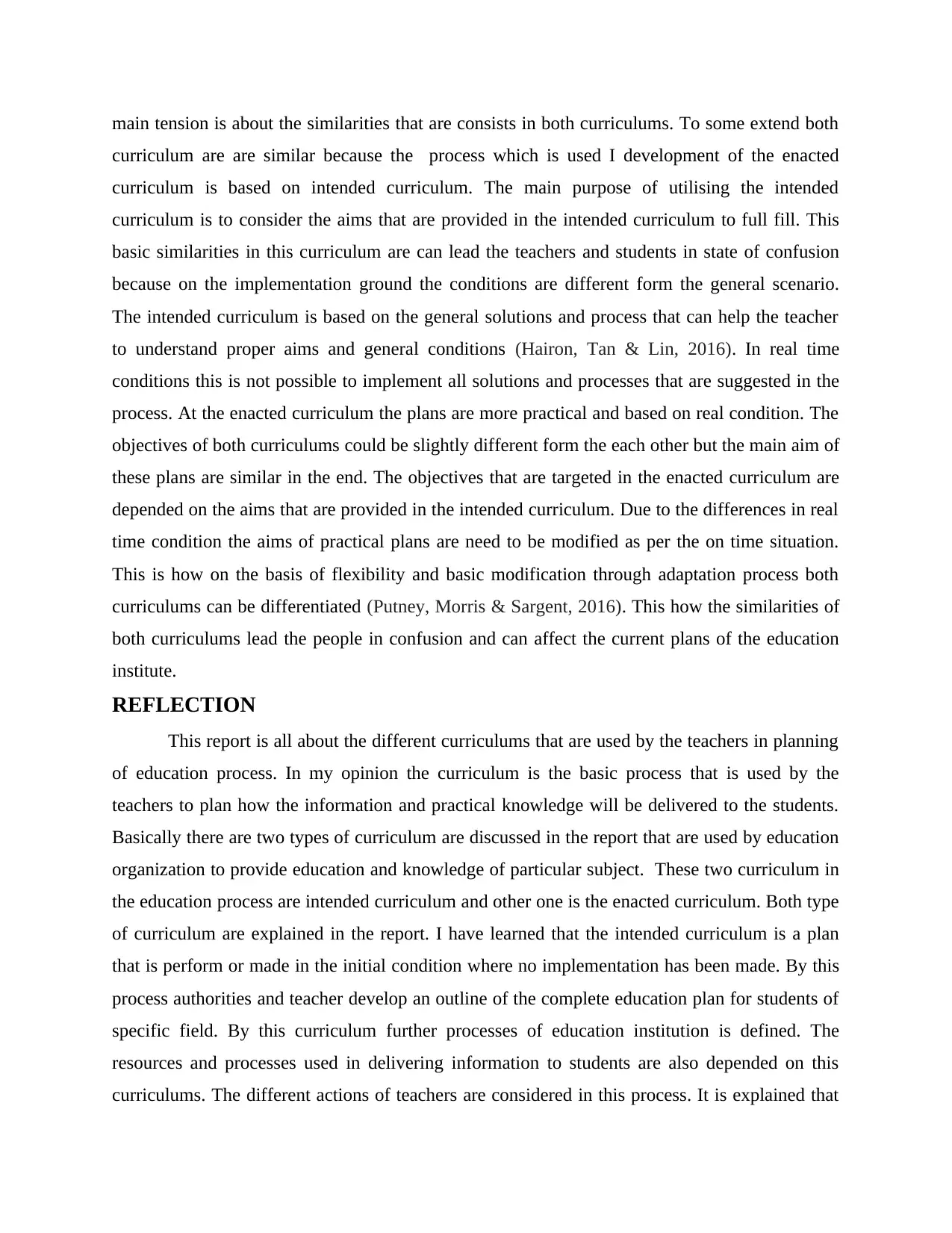
main tension is about the similarities that are consists in both curriculums. To some extend both
curriculum are are similar because the process which is used I development of the enacted
curriculum is based on intended curriculum. The main purpose of utilising the intended
curriculum is to consider the aims that are provided in the intended curriculum to full fill. This
basic similarities in this curriculum are can lead the teachers and students in state of confusion
because on the implementation ground the conditions are different form the general scenario.
The intended curriculum is based on the general solutions and process that can help the teacher
to understand proper aims and general conditions (Hairon, Tan & Lin, 2016). In real time
conditions this is not possible to implement all solutions and processes that are suggested in the
process. At the enacted curriculum the plans are more practical and based on real condition. The
objectives of both curriculums could be slightly different form the each other but the main aim of
these plans are similar in the end. The objectives that are targeted in the enacted curriculum are
depended on the aims that are provided in the intended curriculum. Due to the differences in real
time condition the aims of practical plans are need to be modified as per the on time situation.
This is how on the basis of flexibility and basic modification through adaptation process both
curriculums can be differentiated (Putney, Morris & Sargent, 2016). This how the similarities of
both curriculums lead the people in confusion and can affect the current plans of the education
institute.
REFLECTION
This report is all about the different curriculums that are used by the teachers in planning
of education process. In my opinion the curriculum is the basic process that is used by the
teachers to plan how the information and practical knowledge will be delivered to the students.
Basically there are two types of curriculum are discussed in the report that are used by education
organization to provide education and knowledge of particular subject. These two curriculum in
the education process are intended curriculum and other one is the enacted curriculum. Both type
of curriculum are explained in the report. I have learned that the intended curriculum is a plan
that is perform or made in the initial condition where no implementation has been made. By this
process authorities and teacher develop an outline of the complete education plan for students of
specific field. By this curriculum further processes of education institution is defined. The
resources and processes used in delivering information to students are also depended on this
curriculums. The different actions of teachers are considered in this process. It is explained that
curriculum are are similar because the process which is used I development of the enacted
curriculum is based on intended curriculum. The main purpose of utilising the intended
curriculum is to consider the aims that are provided in the intended curriculum to full fill. This
basic similarities in this curriculum are can lead the teachers and students in state of confusion
because on the implementation ground the conditions are different form the general scenario.
The intended curriculum is based on the general solutions and process that can help the teacher
to understand proper aims and general conditions (Hairon, Tan & Lin, 2016). In real time
conditions this is not possible to implement all solutions and processes that are suggested in the
process. At the enacted curriculum the plans are more practical and based on real condition. The
objectives of both curriculums could be slightly different form the each other but the main aim of
these plans are similar in the end. The objectives that are targeted in the enacted curriculum are
depended on the aims that are provided in the intended curriculum. Due to the differences in real
time condition the aims of practical plans are need to be modified as per the on time situation.
This is how on the basis of flexibility and basic modification through adaptation process both
curriculums can be differentiated (Putney, Morris & Sargent, 2016). This how the similarities of
both curriculums lead the people in confusion and can affect the current plans of the education
institute.
REFLECTION
This report is all about the different curriculums that are used by the teachers in planning
of education process. In my opinion the curriculum is the basic process that is used by the
teachers to plan how the information and practical knowledge will be delivered to the students.
Basically there are two types of curriculum are discussed in the report that are used by education
organization to provide education and knowledge of particular subject. These two curriculum in
the education process are intended curriculum and other one is the enacted curriculum. Both type
of curriculum are explained in the report. I have learned that the intended curriculum is a plan
that is perform or made in the initial condition where no implementation has been made. By this
process authorities and teacher develop an outline of the complete education plan for students of
specific field. By this curriculum further processes of education institution is defined. The
resources and processes used in delivering information to students are also depended on this
curriculums. The different actions of teachers are considered in this process. It is explained that
⊘ This is a preview!⊘
Do you want full access?
Subscribe today to unlock all pages.

Trusted by 1+ million students worldwide

how teacher and instructor operate when they are following a specific curriculum to provide
education to the students. I have learned that role of teacher is most crucial in the education
institute because all the actions that are defined in the education process are executed by
teachers. The success and implementation of complete plan is depended on the teachers and
instructors. I have also learned about the role of the student in class room while the enacted
curriculum is under implementation process. It is also learned that how the students can help the
teacher and institute to improve the efficiency of the enacted curriculum. In my opinion the
orientation that are considered for the improvement of curriculum planning can be used to
improve the effectiveness of education planning. By consideration of the curriculum
complexities of planning and execution can be reduced. According to me by improving the
insight awareness of curriculum teachers can improve the standard of education and information
that is provided to the students. I have experiences that there are some similarities in intended
and enacted curriculum that can create tension in understanding process.
CONCLUSION
This report is concluding the importance of curriculum in the education institute to
provide better education conditions to students. It has been analysed that how these curriculums
can used in the education organization to reduce the complexity of the teaching process. There
are various aspects of curriculum has been analysed to analyse its importance of the education
organization.
education to the students. I have learned that role of teacher is most crucial in the education
institute because all the actions that are defined in the education process are executed by
teachers. The success and implementation of complete plan is depended on the teachers and
instructors. I have also learned about the role of the student in class room while the enacted
curriculum is under implementation process. It is also learned that how the students can help the
teacher and institute to improve the efficiency of the enacted curriculum. In my opinion the
orientation that are considered for the improvement of curriculum planning can be used to
improve the effectiveness of education planning. By consideration of the curriculum
complexities of planning and execution can be reduced. According to me by improving the
insight awareness of curriculum teachers can improve the standard of education and information
that is provided to the students. I have experiences that there are some similarities in intended
and enacted curriculum that can create tension in understanding process.
CONCLUSION
This report is concluding the importance of curriculum in the education institute to
provide better education conditions to students. It has been analysed that how these curriculums
can used in the education organization to reduce the complexity of the teaching process. There
are various aspects of curriculum has been analysed to analyse its importance of the education
organization.
Paraphrase This Document
Need a fresh take? Get an instant paraphrase of this document with our AI Paraphraser
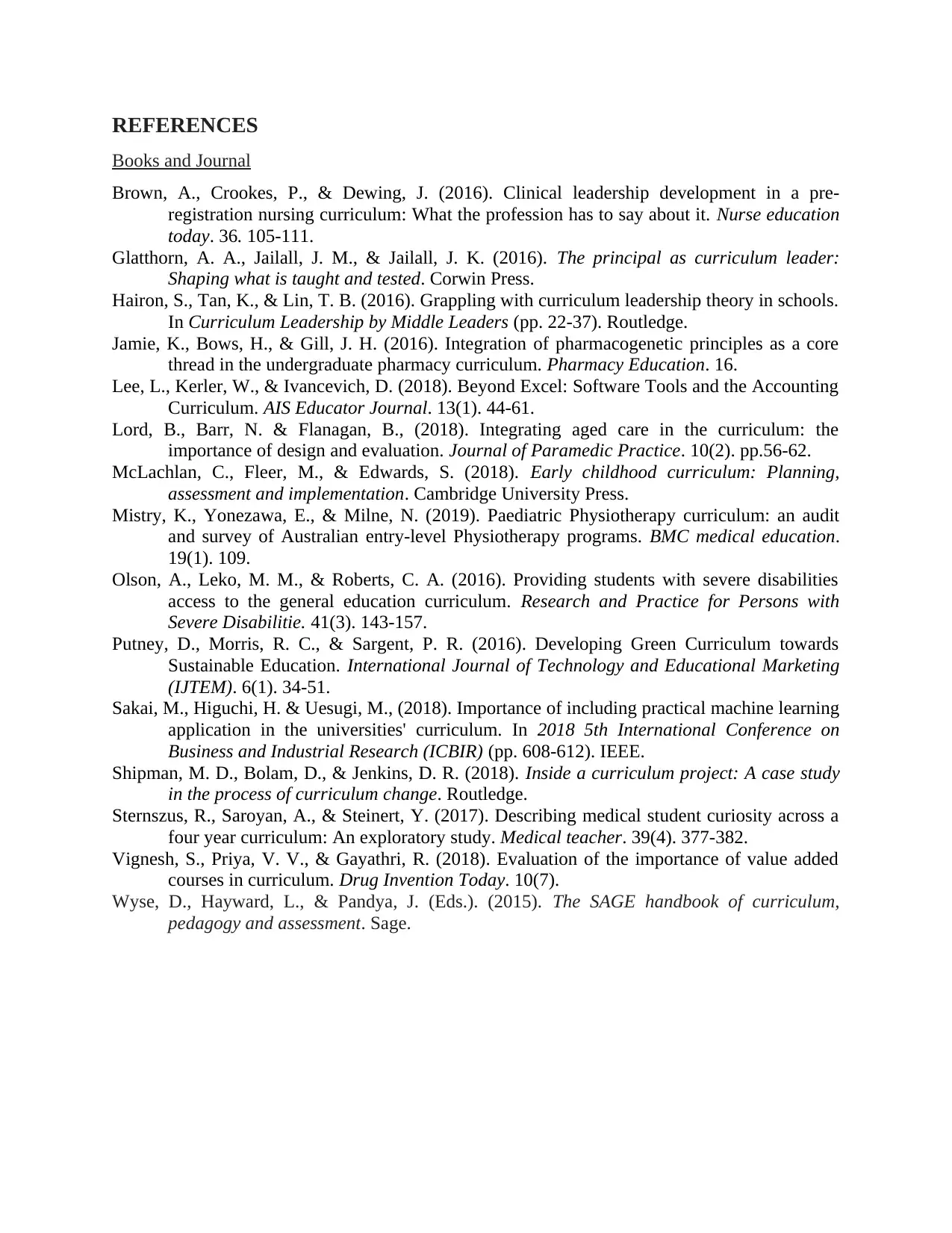
REFERENCES
Books and Journal
Brown, A., Crookes, P., & Dewing, J. (2016). Clinical leadership development in a pre-
registration nursing curriculum: What the profession has to say about it. Nurse education
today. 36. 105-111.
Glatthorn, A. A., Jailall, J. M., & Jailall, J. K. (2016). The principal as curriculum leader:
Shaping what is taught and tested. Corwin Press.
Hairon, S., Tan, K., & Lin, T. B. (2016). Grappling with curriculum leadership theory in schools.
In Curriculum Leadership by Middle Leaders (pp. 22-37). Routledge.
Jamie, K., Bows, H., & Gill, J. H. (2016). Integration of pharmacogenetic principles as a core
thread in the undergraduate pharmacy curriculum. Pharmacy Education. 16.
Lee, L., Kerler, W., & Ivancevich, D. (2018). Beyond Excel: Software Tools and the Accounting
Curriculum. AIS Educator Journal. 13(1). 44-61.
Lord, B., Barr, N. & Flanagan, B., (2018). Integrating aged care in the curriculum: the
importance of design and evaluation. Journal of Paramedic Practice. 10(2). pp.56-62.
McLachlan, C., Fleer, M., & Edwards, S. (2018). Early childhood curriculum: Planning,
assessment and implementation. Cambridge University Press.
Mistry, K., Yonezawa, E., & Milne, N. (2019). Paediatric Physiotherapy curriculum: an audit
and survey of Australian entry-level Physiotherapy programs. BMC medical education.
19(1). 109.
Olson, A., Leko, M. M., & Roberts, C. A. (2016). Providing students with severe disabilities
access to the general education curriculum. Research and Practice for Persons with
Severe Disabilitie. 41(3). 143-157.
Putney, D., Morris, R. C., & Sargent, P. R. (2016). Developing Green Curriculum towards
Sustainable Education. International Journal of Technology and Educational Marketing
(IJTEM). 6(1). 34-51.
Sakai, M., Higuchi, H. & Uesugi, M., (2018). Importance of including practical machine learning
application in the universities' curriculum. In 2018 5th International Conference on
Business and Industrial Research (ICBIR) (pp. 608-612). IEEE.
Shipman, M. D., Bolam, D., & Jenkins, D. R. (2018). Inside a curriculum project: A case study
in the process of curriculum change. Routledge.
Sternszus, R., Saroyan, A., & Steinert, Y. (2017). Describing medical student curiosity across a
four year curriculum: An exploratory study. Medical teacher. 39(4). 377-382.
Vignesh, S., Priya, V. V., & Gayathri, R. (2018). Evaluation of the importance of value added
courses in curriculum. Drug Invention Today. 10(7).
Wyse, D., Hayward, L., & Pandya, J. (Eds.). (2015). The SAGE handbook of curriculum,
pedagogy and assessment. Sage.
Books and Journal
Brown, A., Crookes, P., & Dewing, J. (2016). Clinical leadership development in a pre-
registration nursing curriculum: What the profession has to say about it. Nurse education
today. 36. 105-111.
Glatthorn, A. A., Jailall, J. M., & Jailall, J. K. (2016). The principal as curriculum leader:
Shaping what is taught and tested. Corwin Press.
Hairon, S., Tan, K., & Lin, T. B. (2016). Grappling with curriculum leadership theory in schools.
In Curriculum Leadership by Middle Leaders (pp. 22-37). Routledge.
Jamie, K., Bows, H., & Gill, J. H. (2016). Integration of pharmacogenetic principles as a core
thread in the undergraduate pharmacy curriculum. Pharmacy Education. 16.
Lee, L., Kerler, W., & Ivancevich, D. (2018). Beyond Excel: Software Tools and the Accounting
Curriculum. AIS Educator Journal. 13(1). 44-61.
Lord, B., Barr, N. & Flanagan, B., (2018). Integrating aged care in the curriculum: the
importance of design and evaluation. Journal of Paramedic Practice. 10(2). pp.56-62.
McLachlan, C., Fleer, M., & Edwards, S. (2018). Early childhood curriculum: Planning,
assessment and implementation. Cambridge University Press.
Mistry, K., Yonezawa, E., & Milne, N. (2019). Paediatric Physiotherapy curriculum: an audit
and survey of Australian entry-level Physiotherapy programs. BMC medical education.
19(1). 109.
Olson, A., Leko, M. M., & Roberts, C. A. (2016). Providing students with severe disabilities
access to the general education curriculum. Research and Practice for Persons with
Severe Disabilitie. 41(3). 143-157.
Putney, D., Morris, R. C., & Sargent, P. R. (2016). Developing Green Curriculum towards
Sustainable Education. International Journal of Technology and Educational Marketing
(IJTEM). 6(1). 34-51.
Sakai, M., Higuchi, H. & Uesugi, M., (2018). Importance of including practical machine learning
application in the universities' curriculum. In 2018 5th International Conference on
Business and Industrial Research (ICBIR) (pp. 608-612). IEEE.
Shipman, M. D., Bolam, D., & Jenkins, D. R. (2018). Inside a curriculum project: A case study
in the process of curriculum change. Routledge.
Sternszus, R., Saroyan, A., & Steinert, Y. (2017). Describing medical student curiosity across a
four year curriculum: An exploratory study. Medical teacher. 39(4). 377-382.
Vignesh, S., Priya, V. V., & Gayathri, R. (2018). Evaluation of the importance of value added
courses in curriculum. Drug Invention Today. 10(7).
Wyse, D., Hayward, L., & Pandya, J. (Eds.). (2015). The SAGE handbook of curriculum,
pedagogy and assessment. Sage.
1 out of 11
Related Documents
Your All-in-One AI-Powered Toolkit for Academic Success.
+13062052269
info@desklib.com
Available 24*7 on WhatsApp / Email
![[object Object]](/_next/static/media/star-bottom.7253800d.svg)
Unlock your academic potential
© 2024 | Zucol Services PVT LTD | All rights reserved.





